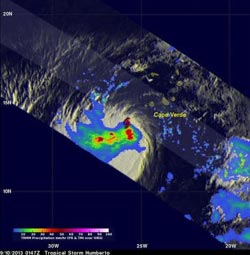NASA sees heavy rainfall in strengthening Tropical Storm Humberto

NASA's TRMM satellite showed a large area of heavy rain (red) south of Humberto's center of circulation on Sept. 9 at 9:47 p.m. EDT. A red tropical storm symbol shows Humberto's approximate center.<br><br>Credit: SSAI/NASA, Hal Pierce<br>
NASA's Tropical Rainfall Measuring Mission satellite called TRMM passed near Humberto on September 10, 2013 at 0147 UTC (9:47 p.m. Sept. 9) and collected data used in this rainfall analysis. TRMM's Microwave Imager (TMI) and Precipitation Radar (PR) showed a large area of heavy rain south of Humberto's center of circulation. Rain was falling at a rate of 2 inches/50 mm per hour.
At 11 a.m. EDT on Sept. 10, Humberto's maximum sustained winds were near 65 mph/100 kph, just 9 mph shy of hurricane-force. Humberto is now predicted by the National Hurricane Center (NHC) to become a hurricane later today, Sept. 10.
The center of Tropical Storm Humberto was located near latitude 14.6 north and longitude 27.7 west, about 220 miles/355 km west of the southernmost Cape Verde Islands. Humberto is moving toward the west-northwest near 9 mph/15 kph and is expected to turn to the northwest later today then north. The estimated minimum central pressure is 998 millibars.
If Humberto becomes a hurricane, it would be the first of the Atlantic Ocean season.
Media Contact
More Information:
http://www.nasa.govAll latest news from the category: Earth Sciences
Earth Sciences (also referred to as Geosciences), which deals with basic issues surrounding our planet, plays a vital role in the area of energy and raw materials supply.
Earth Sciences comprises subjects such as geology, geography, geological informatics, paleontology, mineralogy, petrography, crystallography, geophysics, geodesy, glaciology, cartography, photogrammetry, meteorology and seismology, early-warning systems, earthquake research and polar research.
Newest articles

“Nanostitches” enable lighter and tougher composite materials
In research that may lead to next-generation airplanes and spacecraft, MIT engineers used carbon nanotubes to prevent cracking in multilayered composites. To save on fuel and reduce aircraft emissions, engineers…

Trash to treasure
Researchers turn metal waste into catalyst for hydrogen. Scientists have found a way to transform metal waste into a highly efficient catalyst to make hydrogen from water, a discovery that…

Real-time detection of infectious disease viruses
… by searching for molecular fingerprinting. A research team consisting of Professor Kyoung-Duck Park and Taeyoung Moon and Huitae Joo, PhD candidates, from the Department of Physics at Pohang University…




















